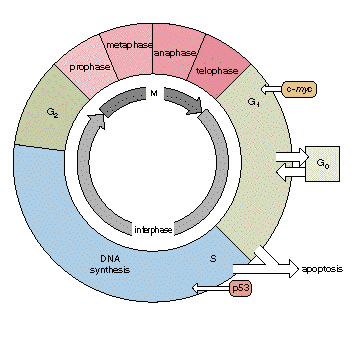
Figure 3. Cycle of events leading to cell division is under strict genetic control. Resting cells are in the phase called Gap0 (G0). During this period cells cannot divide, but they can differentiate by maturing and taking on the functions of the mature cell type. When cells receive external cues to divide they enter the cycle at the Gap1 (G1) phase. During G1, cells manufacture cellular components, such as RNA and proteins, in preparation for division. After a time, the cells enter the Synthesis (S) phase in which the cell’s DNA is duplicated. During the next phase, Gap2 (G2), the cell continues to manufacture proteins and RNA. Finally, the cell undergoes Mitosis (M), during which each daughter cell receives a complete set of the cell’s genes, along with all of the other constituents it needs to function and mature. To ensure that cell division equals apoptotic cell loss the cell’s response to growth cues is regulated, for example, by the protein Myc, encoded by the gene c-myc, which exerts its effects during the G1 phase of the cycle. In order that DNA be faithfully duplicated, checkpoints exist at certain steps of the cell cycle. The p53 protein mediates a checkpoint when the cell enters the S phase. If all is well, the cell continues with the cycle. But if the DNA is damaged, the cell cycle is stopped to allow for DNA repair. If the damage is so severe that it cannot be fixed, the cell exits the cycle and instead undergoes apoptosis. Mutations in the c-myc gene, in the p53 gene or in any of the many other regulatory genes, or the genes that encode proteins that correct defects in DNA, alter the cell cycle. Alterations lead the cell to proceed through the cell cycle with damaged DNA, which contributes to the kinds of chromosomal anomalies seen in Figure 2. These in turn lead to further deregulation of the cell cycle such that cellular proliferation is excessive, and apoptosis reduced. The net effect is an overabundance of cells, which is basically the situation in cancer.

